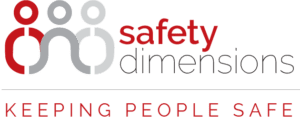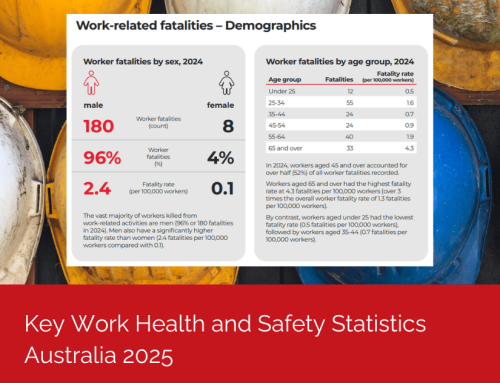
Toolbox talks provide an opportunity to discuss safety practices, address concerns, and reinforce the importance of staying safe on the job.
Running out of toolbox talk ideas? Here are 30 toolbox talk topics that you can use in your toolbox talks or pre-start meetings to keep your teams informed and safe.
Here’s a list of 30 topic ideas to help with your next toolbox
-
1. Understanding the true cost of workplace accidents
Highlight both the direct and indirect costs of workplace accidents, including medical expenses, lost productivity, and potential fines or legal fees. Use real-world examples to illustrate the financial and human impact, and stress the importance of investing in safety measures to prevent accidents.
-
2. Know your rights and responsibilities
Outline the legal rights and responsibilities of workers under workplace safety regulations. Discuss specific rights, such as the right to refuse unsafe work, and responsibilities, such as following safety procedures and reporting hazards. Use case studies to highlight the importance of understanding these rights and responsibilities.
-
3. Notifiable events explained: what you need to know
Define what qualifies as a notifiable incident and explain the legal requirements for reporting such events. Include examples of notifiable events and the potential consequences of failing to report. Discuss the importance of timely and accurate reporting for compliance and overall workplace safety.
-
4. The dangers of distracted driving
Highlight the various forms of distracted driving, including texting, eating, and using in-car technologies. Share statistics on accidents caused by distracted driving and discuss strategies to minimise distractions, such as designated phone use areas and driver education programs.
-
5. Near misses: reporting to prevent future accidents
Explain what constitutes a near miss and why reporting them is crucial for preventing future accidents. Provide examples of near misses and the lessons learned from them. Encourage a culture of speaking up where employees feel comfortable reporting near misses without fear of repercussions.
-
6. Building a strong safety culture
Discuss the elements that make up a strong safety culture, including leadership commitment, employee involvement, and continuous improvement. Share strategies for fostering a positive safety culture, such as regular safety meetings, speaking up, training programs, and recognition of safe behaviours. Highlight the benefits of a strong safety culture for both employees and the organisation.
-
7. Maintaining your PPE: the key to personal safety
Emphasise the importance of personal protective equipment (PPE) in preventing injuries. Cover the proper selection, use, and maintenance of PPE. Provide demonstrations or visual aids to show correct PPE usage and common mistakes to avoid.
-
8. Fitness for work: ensuring safety and efficiency
Discuss how physical and mental fitness affects workplace safety and performance. Cover topics such as the impact of fatigue, substance abuse, and stress on work ability. Offer tips for maintaining fitness, such as healthy eating, regular exercise, and stress management techniques.
-
9. Healthy habits for a safer workplace
Encourage the adoption of healthy lifestyle choices that enhance work performance and reduce health-related absences. Discuss the benefits of regular exercise, balanced nutrition, adequate sleep, and hydration. Provide practical tips and resources for employees to improve their health habits.
-
10. Looking out for our mates: team safety
Promote a culture of teamwork and mutual support where employees look out for each other’s safety. Discuss the importance of peer observations, buddy systems, and open communication about safety concerns. Share examples of how looking out for teammates can prevent accidents and injuries.
-
11. Supporting new workers into the workplace
Highlight the importance of a thorough induction process for new employees to ensure they understand workplace safety procedures and culture. Discuss key elements of an effective induction program, such as site tours, safety training, and introductions to key personnel. Emphasise the role of ongoing support and mentorship.
-
12. Dealing with workplace bullying
Provide strategies and best practices for addressing and preventing workplace bullying. Discuss the impact of bullying on individuals and the workplace, how to recognise signs of bullying, and steps to take if bullying occurs. Highlight the importance of a respectful and inclusive work environment.
-
13. Managing fatigue at work
Identify the signs of fatigue and its impact on safety and productivity. Discuss strategies to manage and reduce fatigue, such as proper scheduling, rest breaks, and workload management. Provide tips for improving sleep quality and overall energy levels.
-
14. Heat stress: prevention and awareness
Highlight how to prevent heat stress through proper hydration, rest breaks, and understanding the signs of heat-related illnesses. Discuss the importance of acclimatisation, wearing appropriate clothing, and providing cool areas for breaks.
-
15. Keeping lone workers safe
Explore measures to ensure the safety and well-being of employees who work alone. Discuss the importance of regular check-ins, communication protocols, and emergency procedures. Provide examples of effective lone worker safety systems.
-
16. The importance of speaking up
Encourage open communication about safety concerns and empower employees to speak up without fear of reprisal. Discuss the benefits of a reporting culture and provide examples of how speaking up has prevented accidents. Highlight the importance of management support and response.
-
17. Understanding psychosocial hazards
Define psychosocial hazards and discuss strategies to manage stress, bullying, and harassment at work. Cover topics such as workload management, work-life balance, and support resources. Provide tools for assessing and addressing psychosocial risks.
-
18. Mental health leave: what you need to know
Outline the provisions and benefits of mental health leave to support employees dealing with mental health issues. Discuss how to apply for mental health leave, the types of support available, and the importance of reducing stigma around mental health.
-
19. Domestic violence leave: rights and support
All employees are entitled to family and domestic violence leave each year. Provide information on your companies policies and procedures, on how to apply for leave, available resources, and workplace support mechanisms. Highlight the importance of a supportive and safe work environment. You may like this related article
-
20. Impact of sleep deprivation
Do your workers know that at the point of sleep deprivation (less than 6.5 hours a night), the likelihood of a workplace accident increases by 70%? Communicate the impact of sleep deprivation on safety and performance. Discuss the signs of sleep deprivation and its effects on cognitive and physical abilities. Provide strategies for improving sleep quality, such as establishing a regular sleep schedule and creating a restful sleep environment. You may like this related article: Sleep deprivation increases the likelihood of a workplace incident
-
21. The benefits of stretching at work
Highlight the importance of regular stretching exercises to prevent musculoskeletal injuries and improve overall flexibility. Provide examples of simple stretches that can be done at the workstation. Discuss the benefits of stretching for reducing muscle tension and improving circulation.
-
22. Ergonomics for working from home
Discuss ergonomic and safety considerations for home offices to prevent injuries and maintain productivity. Cover topics such as proper workstation setup, chair and desk adjustments, and the importance of taking breaks. Provide practical tips for creating an ergonomic home office environment.
-
23. The cost of complacency
Explain how complacency can lead to accidents and discuss ways to stay vigilant and proactive about safety. Share examples of incidents caused by complacency and the lessons learned. Provide strategies for maintaining a high level of awareness and attention to safety.
-
24. Preventing back injuries
Demonstrate techniques and tools to avoid back injuries, including proper lifting methods and ergonomic workplace setups. Discuss the importance of core strength and posture. Provide demonstrations or visual aids to show correct lifting techniques and workstation adjustments.
-
25. The risks of sedentary work and excessive sitting
Discuss the health risks of prolonged sitting and strategies to incorporate more movement into the workday. Highlight the benefits of standing desks, regular breaks, and stretching exercises. Provide tips for creating a more active work environment.
-
26. Applying the hierarchy of controls
Explain how to apply the hierarchy of controls to effectively manage and reduce workplace hazards. Discuss each level of the hierarchy, from elimination to personal protective equipment, and provide examples of how they can be applied in different scenarios.
-
27. What can a regulator’s inspector do at your workplace?
Understand the role and powers of a regulator’s inspector during workplace inspections. Discuss what to expect during an inspection, how to prepare, and the importance of cooperation and compliance. Provide tips for maintaining good relations with regulators.
-
28. Workplace fire safety
Discuss fire safety protocols specific to the office or site environment. Cover the importance of keeping exits clear, knowing the location of fire extinguishers, and understanding the site evacuation plan. Emphasise the role of fire drills and the proper use of electrical equipment and flammable substances to prevent fire hazards. You may like this related article: Test your emergency response plan now.
- 29. Effective communication in the workplace
Highlight the importance of clear and effective communication among staff. Discuss strategies for improving communication, such as active listening, clear messaging, and the appropriate use of email and other communication tools. Emphasise the role of communication in preventing misunderstandings and fostering a collaborative work environment. -
30. Stinging insect and bug protection
Provide tips and strategies to protect employees who work outdoors from stinging insects and bugs. Discuss the importance of wearing protective clothing, using insect repellent, and being aware of the environment. Provide information on first aid treatment for insect stings and bites.
Other articles you may like about toolbox talks: How to run an effective toolbox or pre-start talk






